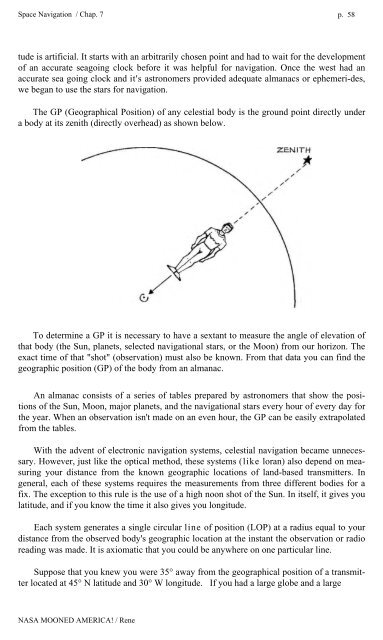Rene-NASA-Mooned-America
Rene-NASA-Mooned-America
Rene-NASA-Mooned-America
Create successful ePaper yourself
Turn your PDF publications into a flip-book with our unique Google optimized e-Paper software.
Space Navigation / Chap. 7 p. 58<br />
tude is artificial. It starts with an arbitrarily chosen point and had to wait for the development<br />
of an accurate seagoing clock before it was helpful for navigation. Once the west had an<br />
accurate sea going clock and it's astronomers provided adequate almanacs or ephemeri-des,<br />
we began to use the stars for navigation.<br />
The GP (Geographical Position) of any celestial body is the ground point directly under<br />
a body at its zenith (directly overhead) as shown below.<br />
To determine a GP it is necessary to have a sextant to measure the angle of elevation of<br />
that body (the Sun, planets, selected navigational stars, or the Moon) from our horizon. The<br />
exact time of that "shot" (observation) must also be known. From that data you can find the<br />
geographic position (GP) of the body from an almanac.<br />
An almanac consists of a series of tables prepared by astronomers that show the positions<br />
of the Sun, Moon, major planets, and the navigational stars every hour of every day for<br />
the year. When an observation isn't made on an even hour, the GP can be easily extrapolated<br />
from the tables.<br />
With the advent of electronic navigation systems, celestial navigation became unnecessary.<br />
However, just like the optical method, these systems (like loran) also depend on measuring<br />
your distance from the known geographic locations of land-based transmitters. In<br />
general, each of these systems requires the measurements from three different bodies for a<br />
fix. The exception to this rule is the use of a high noon shot of the Sun. In itself, it gives you<br />
latitude, and if you know the time it also gives you longitude.<br />
Each system generates a single circular line of position (LOP) at a radius equal to your<br />
distance from the observed body's geographic location at the instant the observation or radio<br />
reading was made. It is axiomatic that you could be anywhere on one particular line.<br />
Suppose that you knew you were 35° away from the geographical position of a transmitter<br />
located at 45° N latitude and 30° W longitude. If you had a large globe and a large<br />
<strong>NASA</strong> MOONED AMERICA! / <strong>Rene</strong>


